动词ing形式作表语,定语和宾语补足语.
必修4动词-ing形式作表语、定语、宾语补足语和状语

年级高一学科英语版本人教实验版内容标题必修4 Unit 3 A taste of English humor动词-ing形式作表语、定语、宾语补足语和状语编稿老师林静【本讲教育信息】一. 教学内容:动词-ing形式作表语、定语、宾语补足语和状语二. 知识精讲(一)动词的ing形式作表语1. 动名词作表语一般表示抽象的、习惯性的行为,这时主语与表语的位置可以互换。
Her duty is taking care of the babies.照看婴儿是她的职责。
Our job is playing all kinds of music.我们的工作就是演奏各种音乐2. 现在分词作表语,表明的是主语的性质与特征,相当于形容词,可有比较级形式,亦可被very, quite,so等副词修饰,这时主语与表语的位置不可互换The music they are playing sounds exciting.他们演奏的音乐是如此令人兴奋The film we saw last night is quite moving.我们昨晚看的电影十分感人。
(二)动词的ing形式作定语1. 动名词作定语,表示该名词的用途或与其有关的动作,通常只能放在所修饰的名词前。
a walking stick手杖 reading room 阅览室 washing machine洗衣机2.现在分词作定语,说明所修饰的名词正在进行的动作或存在的状态,现在分词与所修饰的名词具有逻辑上的主谓关系,可换成定语从句来表达,单个的现在分词作定语常置于被修饰的名词前,现在分词短语作定语须置于被修饰的名词后。
Nobody can stop the running horse(=the horse that is running).没人能阻止那匹奔跑的马。
The student making the experiment(=who is making the experiment) is our monitor.正在做实验的那个学生是我们的班长。
动词的-ing形式作表语,定语,宾语补足语
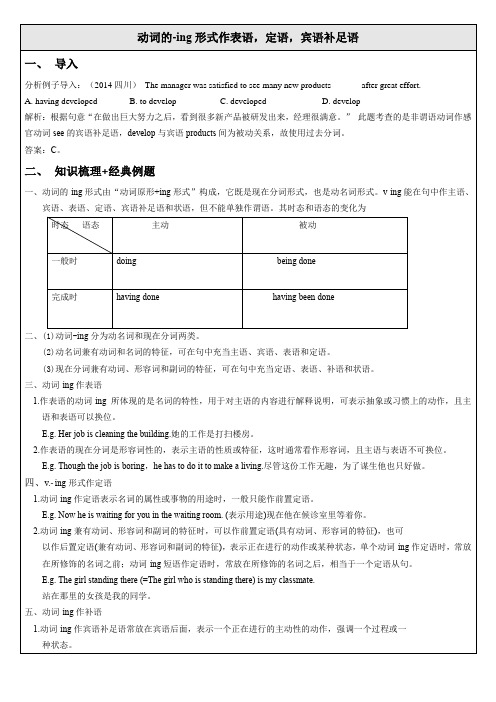
1)位于感官动词后(see,hear,feel,smell,watch,find,notice等)。
E.g.I felt somebody patting me on the shoulder.我感到有人拍我的肩膀。
动词的-ing形式作表语,定语,宾语补足语
一、导入
分析例子导入:(2014四川)The managerwas satisfied to see many new products ______ after great effort.
A. having developedB. to develop C. developedD. develop
时态语态
主动
被动
一般时
doing
being done
完成时
having done
having been done
二、(1)动词-ing分为动名词和现在分词两类。
(2)动名词兼有动词和名词的特征,可在句中充当主语、宾语、表语和定语。
(3)现在分词兼有动词、形容词和副词的特征,可在句中充当定语、表语、补语和状语。
2.动词-ing兼有动词、形容词和副词的特征时,可以作前置定语(具有动词、形容词的特征),也可
以作后置定语(兼有动词、形容词和副词的特征),表示正在进行的动作或某种状态,单个动词-ing作定语时,常放在所修饰的名词之前;动词-ing短语作定语时,常放在所修饰的名词之后,相当于一个定语从句。
E.g.The girl standing there (=The girl who is standing there) is my classmate.
英语动词-ing作表语、定语、宾语补足语
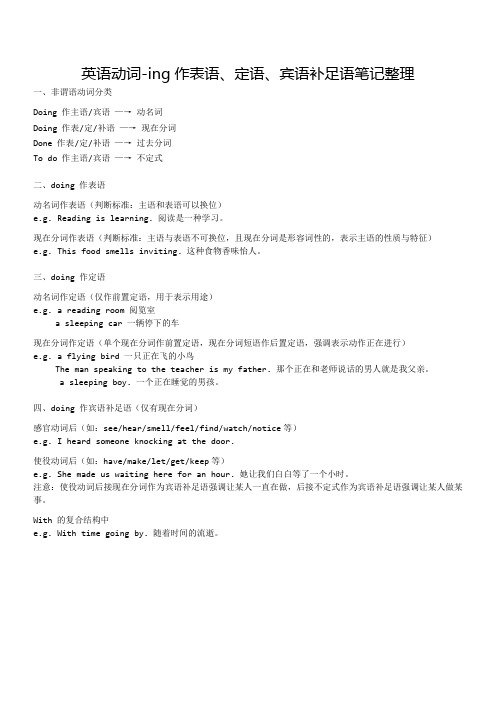
英语动词-ing作表语、定语、宾语补足语笔记整理一、非谓语动词分类Doing作主语/宾语—→动名词Doing 作表/定/补语—→现在分词Done 作表/定/补语—→过去分词To do 作主语/宾语—→不定式二、doing 作表语动名词作表语(判断标准:主语和表语可以换位)e.g. Reading is learning. 阅读是一种学习。
现在分词作表语(判断标准:主语与表语不可换位,且现在分词是形容词性的,表示主语的性质与特征)e.g. This food smells inviting. 这种食物香味怡人。
三、doing 作定语动名词作定语(仅作前置定语,用于表示用途)e.g. a reading room 阅览室a sleeping car 一辆停下的车现在分词作定语(单个现在分词作前置定语,现在分词短语作后置定语,强调表示动作正在进行)e.g. a flying bird 一只正在飞的小鸟The man speaking to the teacher is my father. 那个正在和老师说话的男人就是我父亲。
a sleeping boy. 一个正在睡觉的男孩。
四、doing 作宾语补足语(仅有现在分词)感官动词后(如:see/hear/smell/feel/find/watch/notice等)e.g. I heard someone knocking at the door.使役动词后(如:have/make/let/get/keep等)e.g. She made us waiting here for an hour. 她让我们白白等了一个小时。
注意:使役动词后接现在分词作为宾语补足语强调让某人一直在做,后接不定式作为宾语补足语强调让某人做某事。
With 的复合结构中e.g. With time going by. 随着时间的流逝。
PartⅡGrammar——动词ing形式作表语定语和宾语补足语

PartⅡGrammar——动词ing形式作表语定语和宾语补⾜语Part ⅡGrammar——动词-ing形式作表语、定语和宾语补⾜语[思维导图]⼀、动词-ing形式作表语作表语的动词-ing形式包括现在分词和动名词。
1.现在分词作表语,往往具有形容词的性质,说明主语的性质、特征等。
The result of the game was disappointing.⽐赛结果令⼈失望。
His life story sounds very moving.他的⼈⽣故事听起来很感⼈。
[名师点津]作表语的现在分词,许多是由能够表⽰⼈们某种感情或情绪的动词变化⽽来的。
常见的有:moving,interesting,encouraging,exciting,inspiring,boring,surprising,puzzling,amusing,astonishing...这类分词有“令⼈……的”的含义,常修饰物。
2.动名词作表语多表⽰抽象性的或习惯性的动作,⼀般说明主语的内容。
What I am tired of is waiting here alone.我厌烦独⾃在这⾥等。
My hobby is collecting stamps.我的爱好就是集邮。
⼆、动词-ing形式作定语动名词和现在分词都可以作定语,但有所区别。
1.动名词作定语表⽰被修饰词的某种性能或⽤途,相当于for引导的介词短语。
No one is allowed to speak aloud in the reading room.阅览室⾥不准⼤声说话。
2.现在分词作定语时,它和被修饰词之间有逻辑上的主动关系,表⽰所修饰词进⾏的动作,相当于⼀个定语从句。
The boy playing football on the playground is my younger brother.=The boy that/who is playing football on the playground is my younger brother.在操场上踢⾜球的那个男孩是我的弟弟。
18.动词-ing形式作表语、定语和宾语补足语
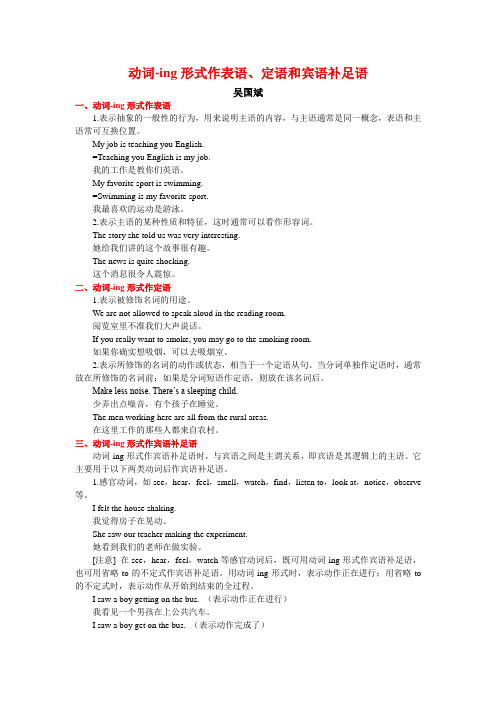
动词-ing形式作表语、定语和宾语补足语吴国斌一、动词-ing形式作表语1.表示抽象的一般性的行为,用来说明主语的内容,与主语通常是同一概念,表语和主语常可互换位置。
My job is teaching you English.=Teaching you English is my job.我的工作是教你们英语。
My favorite sport is swimming.=Swimming is my favorite sport.我最喜欢的运动是游泳。
2.表示主语的某种性质和特征,这时通常可以看作形容词。
The story she told us was very interesting.她给我们讲的这个故事很有趣。
The news is quite shocking.这个消息很令人震惊。
二、动词-ing形式作定语1.表示被修饰名词的用途。
We are not allowed to speak aloud in the reading room.阅览室里不准我们大声说话。
If you really want to smoke, you may go to the smoking room.如果你确实想吸烟,可以去吸烟室。
2.表示所修饰的名词的动作或状态,相当于一个定语从句。
当分词单独作定语时,通常放在所修饰的名词前;如果是分词短语作定语,则放在该名词后。
Make less noise. There’s a sleeping child.少弄出点噪音,有个孩子在睡觉。
The men working here are all from the rural areas.在这里工作的那些人都来自农村。
三、动词-ing形式作宾语补足语动词-ing形式作宾语补足语时,与宾语之间是主谓关系,即宾语是其逻辑上的主语。
它主要用于以下两类动词后作宾语补足语。
1.感官动词,如see,hear,feel,smell,watch,find,listen to,look at,notice,observe 等。
高中英语动词ing形式作表语定语宾语补足语和状语教案新人教版必修

高中英语动词ing形式作表语定语宾语补足语和状语教案新人教版必修一、教学目标1. 让学生掌握动词ing形式在句子中的不同作用,包括作表语、定语、宾语、补足语和状语。
2. 培养学生正确运用动词ing形式的能力,提高他们的英语写作和口语水平。
3. 通过实例分析,让学生了解动词ing形式在实际语境中的应用,增强他们的语言实践能力。
二、教学内容1. 动词ing形式作表语:表示正在进行的动作或状态。
2. 动词ing形式作定语:修饰名词或代词,表示事物的特征或状态。
3. 动词ing形式作宾语:表示动作的承受者。
4. 动词ing形式作补足语:补充说明宾语的状况或程度。
5. 动词ing形式作状语:表示时间、原因、条件等。
三、教学重点与难点1. 重点:动词ing形式在句子中的不同作用及用法。
2. 难点:区分动词ing形式与其他词性的用法,以及在不同语境中的运用。
四、教学方法1. 实例分析:通过大量例句,让学生了解动词ing形式的用法。
2. 互动讨论:鼓励学生积极参与,提问、回答问题,提高他们的口语表达能力。
3. 练习巩固:设计相关练习题,让学生在实际操作中掌握动词ing形式的用法。
五、教学步骤1. 引入:引导学生回顾动词的基本形式,为新课学习做好铺垫。
2. 讲解:讲解动词ing形式在句子中的不同作用,包括作表语、定语、宾语、补足语和状语。
3. 实例分析:分析具体例句,让学生了解动词ing形式的用法。
4. 互动讨论:分组讨论,让学生运用动词ing形式进行口语表达。
5. 练习巩固:布置练习题,让学生巩固所学知识。
6. 总结:对本节课内容进行总结,强调动词ing形式的重要性和应用。
7. 作业布置:设计相关作业,让学生课后巩固所学知识。
六、教学拓展1. 让学生了解动词ing形式在特定语境中的特殊用法,如固定搭配、被动语态等。
2. 引导学生关注动词ing形式在现实生活中的应用,提高他们的语言感知能力。
七、实践与应用1. 设计场景:创设现实生活中的场景,让学生运用动词ing形式进行口语表达。
Grammar动词的ing形式作定语表语和宾语补足语
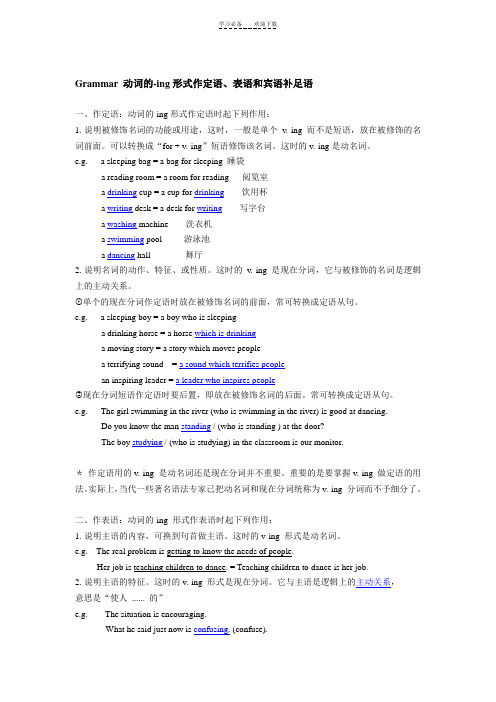
Grammar 动词的-ing形式作定语、表语和宾语补足语一、作定语:动词的-ing形式作定语时起下列作用:1.说明被修饰名词的功能或用途,这时,一般是单个v.-ing 而不是短语,放在被修饰的名词前面。
可以转换成“for + v.-ing”短语修饰该名词。
这时的v.-ing是动名词。
e.g. a sleeping bag = a bag for sleeping 睡袋a reading room = a room for reading 阅览室a drinking cup = a cup for drinking饮用杯a writing desk = a desk for writing写字台a washing machine 洗衣机a swimming pool 游泳池a dancing hall 舞厅2.说明名词的动作、特征、或性质。
这时的v.-ing 是现在分词,它与被修饰的名词是逻辑上的主动关系。
①单个的现在分词作定语时放在被修饰名词的前面,常可转换成定语从句。
e.g. a sleeping boy = a boy who is sleepinga drinking horse = a horse which is drinkinga moving story = a story which moves peoplea terrifying sound = a sound which terrifies peoplean inspiring leader = a leader who inspires people②现在分词短语作定语时要后置,即放在被修饰名词的后面。
常可转换成定语从句。
e.g. The girl swimming in the river (who is swimming in the river) is good at dancing.Do you know the man standing / (who is standing ) at the door?The boy studying / (who is studying) in the classroom is our monitor.*作定语用的v.-ing 是动名词还是现在分词并不重要。
必修4动词-ing形式作表语,定语,宾语补足语和状语

年级高一学科英语版本人教实验版内容标题必修4 Unit 3 A taste of English humor动词-ing形式作表语、定语、宾语补足语和状语编稿老师林静【本讲教育信息】一. 教学内容:动词-ing形式作表语、定语、宾语补足语和状语二. 知识精讲(一)动词的ing形式作表语1. 动名词作表语一般表示抽象的、习惯性的行为,这时主语与表语的位置可以互换。
Her duty is taking care of the babies.照看婴儿是她的职责。
Our job is playing all kinds of music.我们的工作就是演奏各种音乐2. 现在分词作表语,表明的是主语的性质与特征,相当于形容词,可有比较级形式,亦可被very, quite,so等副词修饰,这时主语与表语的位置不可互换The music they are playing sounds exciting.他们演奏的音乐是如此令人兴奋The film we saw last night is quite moving.我们昨晚看的电影十分感人。
(二)动词的ing形式作定语1. 动名词作定语,表示该名词的用途或与其有关的动作,通常只能放在所修饰的名词前。
a walking stick手杖reading room 阅览室washing machine洗衣机2.现在分词作定语,说明所修饰的名词正在进行的动作或存在的状态,现在分词与所修饰的名词具有逻辑上的主谓关系,可换成定语从句来表达,单个的现在分词作定语常置于被修饰的名词前,现在分词短语作定语须置于被修饰的名词后。
Nobody can stop the running horse(=the horse that is running).没人能阻止那匹奔跑的马。
The student making the experiment(=who is making the experiment) is our monitor.正在做实验的那个学生是我们的班长。
动词的ing形式作表语
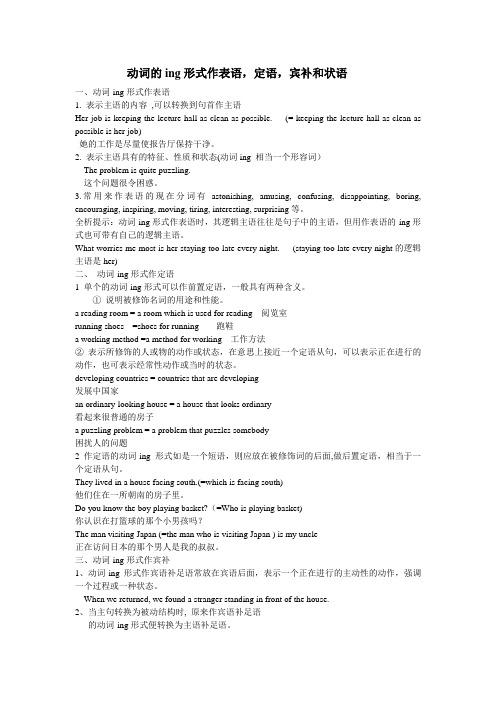
动词的ing形式作表语,定语,宾补和状语一、动词-ing形式作表语1. 表示主语的内容,可以转换到句首作主语Her job is keeping the lecture hall as clean as possible. (= keeping the lecture hall as clean as possible is her job)她的工作是尽量使报告厅保持干净。
2. 表示主语具有的特征、性质和状态(动词ing 相当一个形容词)The problem is quite puzzling.这个问题很令困惑。
3.常用来作表语的现在分词有astonishing, amusing, confusing, disappointing, boring, encouraging, inspiring, moving, tiring, interesting, surprising等。
全析提示:动词-ing形式作表语时,其逻辑主语往往是句子中的主语,但用作表语的-ing形式也可带有自己的逻辑主语。
What worries me most is her staying too late every night. (staying too late every night的逻辑主语是her)二、动词-ing形式作定语1 单个的动词-ing形式可以作前置定语,一般具有两种含义。
①说明被修饰名词的用途和性能。
a reading room = a room which is used for reading 阅览室running shoes =shoes for running 跑鞋a working method =a method for working 工作方法②表示所修饰的人或物的动作或状态,在意思上接近一个定语从句,可以表示正在进行的动作,也可表示经常性动作或当时的状态。
developing countries = countries that are developing发展中国家an ordinary-looking house = a house that looks ordinary看起来很普通的房子a puzzling problem = a problem that puzzles somebody困扰人的问题2 作定语的动词-ing形式如是一个短语,则应放在被修饰词的后面,做后置定语,相当于一个定语从句。
动词-ing形式的用法
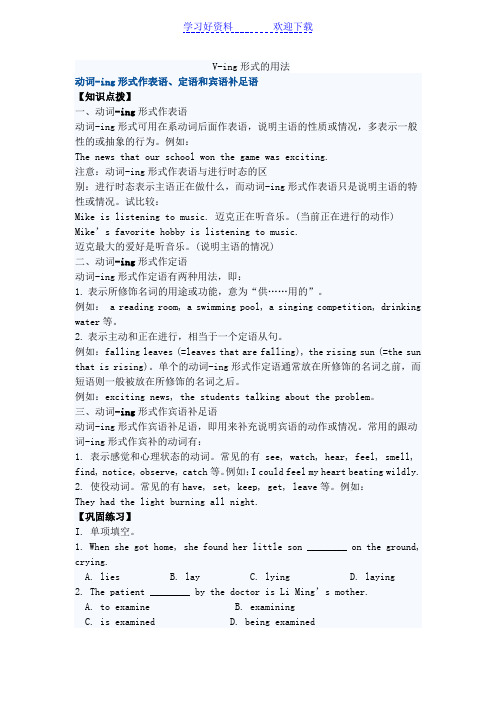
V-ing形式的用法动词-ing形式作表语、定语和宾语补足语【知识点拨】一、动词-ing形式作表语动词-ing形式可用在系动词后面作表语,说明主语的性质或情况,多表示一般性的或抽象的行为。
例如:The news that our school won the game was exciting.注意:动词-ing形式作表语与进行时态的区别:进行时态表示主语正在做什么,而动词-ing形式作表语只是说明主语的特性或情况。
试比较:Mike is listening to music. 迈克正在听音乐。
(当前正在进行的动作) Mike’s favorite hobby is listening to music.迈克最大的爱好是听音乐。
(说明主语的情况)二、动词-ing形式作定语动词-ing形式作定语有两种用法,即:1.表示所修饰名词的用途或功能,意为“供……用的”。
例如: a reading room, a swimming pool, a singing competition, drinking water等。
2.表示主动和正在进行,相当于一个定语从句。
例如:falling leaves (=leaves that are falling), the rising sun (=the sun that is rising)。
单个的动词-ing形式作定语通常放在所修饰的名词之前,而短语则一般被放在所修饰的名词之后。
例如:exciting news, the students talking about the problem。
三、动词-ing形式作宾语补足语动词-ing形式作宾语补足语,即用来补充说明宾语的动作或情况。
常用的跟动词-ing形式作宾补的动词有:1. 表示感觉和心理状态的动词。
常见的有 see, watch, hear, feel, smell, find, notice, observe, catch等。
动词ing作表语,定语,宾补语法讲解

V-ing形式作表语、定语和宾语补足语一V-ing形式作表语1. 动名词作表语表示抽象的、经常性、一般的行为,可与主语互换位置。
现在分词作表语表示主语的特征、性质和状态。
One of his bad habits is smoking while having dinner.Smoking while having dinner is one of his bad habit.The film we saw last night is quite moving. (现在分词)我们昨晚看的电影十分动人。
注:不定式(to do)亦可作表语,但不定式侧重某次具体的动作。
Her job is ___nursing______ (nurse) patients in the hospital; but this weekend her task is ___to look after___________ (look after) her granny.2.使人产生某种情绪或感觉的使动词,如disappoint, amuse, astonish, interest, frighten, puzzle, surprise, move, excite, bore, confuse等,V-ing表示“令人…的”, 而V-ed表示“(人)感到…的”。
I don’t think her joke is amusing at all.I am not amused at her joke at all.The film we saw last night was very moving.We were moved at the film we saw lat night.二V-ing形式作定语动名词作定语用来说明该名词的用途,不表示名词本身的动作;现在分词作定语与所修饰的名词具有逻辑上的主谓关系,即现在分词相当于所修饰名词的谓语。
人教版高中英语【必修四】[动词ing形式作表语-定语和宾语补足语
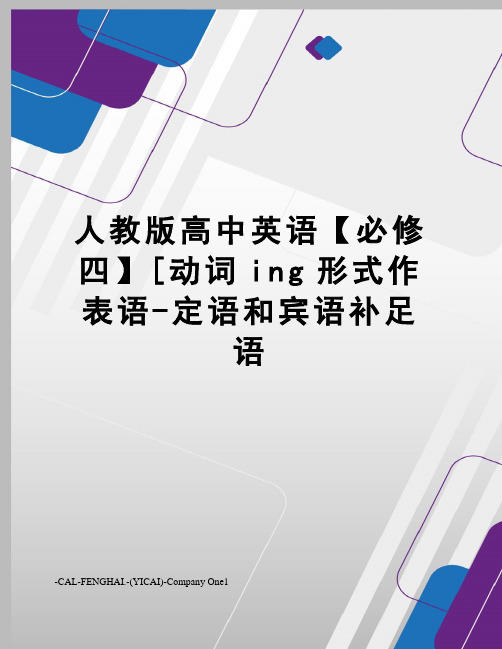
人教版高中英语【必修四】[动词i n g形式作表语-定语和宾语补足语-CAL-FENGHAI.-(YICAI)-Company One1人教版高中英语必修四知识点梳理重点题型(常考知识点)巩固练习动词ing形式作表语,定语和宾语补足语概念引入:The music they are playing sounds so exciting .We watched three boys sharing their food with eachOur job is playing all kinds of music .The girl singing now is a classmate of mine语法讲解【356774 ,非谓语动词之-ing形式,非谓语动词之ing形式】非谓语动词中的ing形式包括两种:一种是动名词,另外一种是现在分词。
•基本形式:1、-ing形式作表语1) -ing形式作表语时放在系动词之后,用来泛指某种动作或行为,以说明主语的具体内容(身份、性质或情况)。
如:Her hobby is painting.她的业余爱好是画画。
My job is looking after the children.我的工作就是照顾这些孩子。
2) –ing用来表示主语所具有的特征,如:His concern for his mother is most touching.他对母亲的关爱很感人。
His words are encouraging.他的话很鼓舞人。
2、-ing形式作定语1). 说明被修饰名词的作用和用途,如:building materials= materials for building 建筑材料drinking water= water for drinking 饮用水a reading room= a room for reading 阅览室2). 说明被修饰名词的作用和用途,如:tiring music= music that is tiring 烦人的音乐a surprising result= a result that is surprising一个惊人的结果3). 表示被修饰名词正在进行的动作,如:正在做实验的那个学生是我们的班长。
高中英语 动词-ing形式作表语 定语 宾语补足语和状语教案 新人教版必修4

课程信息年级高一学英语版本人教实验版科内容标题必修4 Unit 3 A taste of English humor动词-ing形式作表语、定语、宾语补足语和状语编稿老师林静【本讲教育信息】一. 教学内容:动词-ing形式作表语、定语、宾语补足语和状语二. 知识精讲(一)动词的ing形式作表语1. 动名词作表语一般表示抽象的、习惯性的行为,这时主语与表语的位置可以互换。
Her duty is taking care of the babies.照看婴儿是她的职责。
Our job is playing all kinds of music.我们的工作就是演奏各种音乐2. 现在分词作表语,表明的是主语的性质与特征,相当于形容词,可有比较级形式,亦可被very, quite,so等副词修饰,这时主语与表语的位置不可互换The music they are playing sounds exciting.他们演奏的音乐是如此令人兴奋The film we saw last night is quite moving.我们昨晚看的电影十分感人。
(二)动词的ing形式作定语1. 动名词作定语,表示该名词的用途或与其有关的动作,通常只能放在所修饰的名词前。
a walking stick手杖 reading room 阅览室 washing machine洗衣机2.现在分词作定语,说明所修饰的名词正在进行的动作或存在的状态,现在分词与所修饰的名词具有逻辑上的主谓关系,可换成定语从句来表达,单个的现在分词作定语常置于被修饰的名词前,现在分词短语作定语须置于被修饰的名词后。
Nobody can stop the running horse(=the horse that is running).没人能阻止那匹奔跑的马。
The student making the experiment(=who is making the experiment) is our monitor.正在做实验的那个学生是我们的班长。
动词ing形式作表语,定语和宾语补足语

动词ing形式作表语,定语和宾语补足语编稿:张桂琴审稿:梁晓概念引入:The music they are playing sounds so exciting .We watched three boys sharing their food with eachOur job is playing all kinds of music .The girl singing now is a classmate of mine语法讲解【高清课堂:356774 ,非谓语动词之-ing形式,非谓语动词之ing形式】非谓语动词中的ing形式包括两种:一种是动名词,另外一种是现在分词。
•基本形式:1、-ing形式作表语1) -ing形式作表语时放在系动词之后,用来泛指某种动作或行为,以说明主语的具体内容(身份、性质或情况)。
如:Her hobby is painting.她的业余爱好是画画。
My job is looking after the children.我的工作就是照顾这些孩子。
2) –ing用来表示主语所具有的特征,如:His concern for his mother is most touching.他对母亲的关爱很感人。
His words are encouraging.他的话很鼓舞人。
2、-ing形式作定语1). 说明被修饰名词的作用和用途,如:building materials= materials for building 建筑材料drinking water= water for drinking 饮用水a reading room= a room for reading 阅览室2). 说明被修饰名词的作用和用途,如:tiring music= music that is tiring 烦人的音乐a surprising result= a result that is surprising一个惊人的结果3). 表示被修饰名词正在进行的动作,如:正在做实验的那个学生是我们的班长。
人教版高中英语【必修四】[动词ing形式作表语,定语和宾语补足语

人教版高中英语必修四知识点梳理重点题型(常考知识点)巩固练习动词ing形式作表语,定语和宾语补足语概念引入:The music they are playing sounds so exciting .We watched three boys sharing their food with eachOur job is playing all kinds of music .The girl singing now is a classmate of mine语法讲解【356774 ,非谓语动词之-ing形式,非谓语动词之ing形式】非谓语动词中的ing形式包括两种:一种是动名词,另外一种是现在分词。
•基本形式:1、-ing形式作表语1) -ing形式作表语时放在系动词之后,用来泛指某种动作或行为,以说明主语的具体内容(身份、性质或情况)。
如:Her hobby is painting.她的业余爱好是画画。
My job is looking after the children.我的工作就是照顾这些孩子。
2) –ing用来表示主语所具有的特征,如:His concern for his mother is most touching.他对母亲的关爱很感人。
His words are encouraging.他的话很鼓舞人。
2、-ing形式作定语1). 说明被修饰名词的作用和用途,如:building materials= materials for building 建筑材料drinking water= water for drinking 饮用水a reading room= a room for reading 阅览室2). 说明被修饰名词的作用和用途,如:tiring music= music that is tiring 烦人的音乐a surprising result= a result that is surprising一个惊人的结果3). 表示被修饰名词正在进行的动作,如:正在做实验的那个学生是我们的班长。
英语中-ing形式作表语、定语和宾语补足语的用法
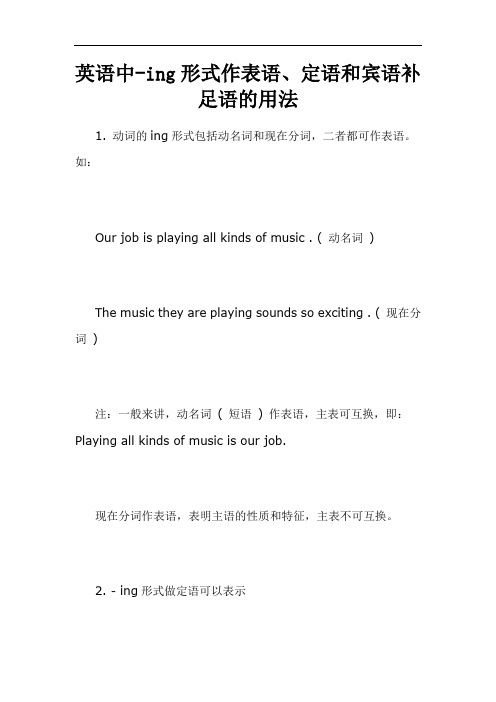
英语中-ing形式作表语、定语和宾语补足语的用法1. 动词的ing形式包括动名词和现在分词,二者都可作表语。
如:Our job is playing all kinds of music . ( 动名词)The music they are playing sounds so exciting . ( 现在分词)注:一般来讲,动名词( 短语) 作表语,主表可互换,即:Playing all kinds of music is our job.现在分词作表语,表明主语的性质和特征,主表不可互换。
2. - ing形式做定语可以表示1 ) 所修饰名词的用途a waiting room ( = a room for waiting ) / a walking stick ( = a stick for walking )2 ) 所修饰名词正在进行的动作,可以换成定语从句形式a waiting man ( = a man who is waiting ) / a sleeping child ( = a child who is sleeping )3. 在see , hear , feel , watch , notice等感观动词后可以用- ing形式做宾语补足语。
这时- ing形式和句子的宾语之间存在着逻辑上的主谓关系,并且- ing形式表示宾语正在进行的动作。
如:He saw a girl getting on the tractor. ( = He saw a girl and the girl was getting on the tractor . )Do you hear someone knocking at the door?1).做宾语补足语We watched three boys sharing their food with each other.2).做主语补足语She was heard singing in the next room.3).做表语和定语My job is teaching English. /a walking stick/a waiting room当-ing分词做定语的时候,常常放在被修饰名词的后面The girl singing now is a classmate of mine.4).做伴随、原因、时间、结果状语He sat at the desk reading a magazine.Being very young, he can't dress himself.Having finished all the work, they went to the shore. Her parents died, leaving her a big house.。
- 1、下载文档前请自行甄别文档内容的完整性,平台不提供额外的编辑、内容补充、找答案等附加服务。
- 2、"仅部分预览"的文档,不可在线预览部分如存在完整性等问题,可反馈申请退款(可完整预览的文档不适用该条件!)。
- 3、如文档侵犯您的权益,请联系客服反馈,我们会尽快为您处理(人工客服工作时间:9:00-18:30)。
概念引入The music they are playing sounds so exciting .We watched three boys sharing their food with eachOur job is playing all kinds of music .The girl singing now is a classmate of mine用法讲解非谓语动词中的ing形式包括两种:一种是动名词,另外一种是现在分词。
•基本形式:1、-ing形式作表语1) -ing形式作表语时放在系动词之后,用来泛指某种动作或行为,以说明主语的具体内容(身份、性质或情况)。
如:Her hobby is painting.她的业余爱好是画画。
My job is looking after the children.我的工作就是照顾这些孩子。
2) –ing用来表示主语所具有的特征,如:His concern for his mother is most touching.他对母亲的关爱很感人。
His words are encouraging.他的话很鼓舞人。
2、-ing形式作定语1). 说明被修饰名词的作用和用途,如:building materials= materials for building 建筑材料drinking water= water for drinking 饮用水a reading room= a room for reading 阅览室2). 说明被修饰名词的性质和程度,如:tiring music= music that is tiring 烦人的音乐a surprising result= a result that is surprising一个惊人的结果3). 表示被修饰名词正在进行的动作,如:正在做实验的那个学生是我们的班长。
The student making the experiment is our monitor.我们能看到冉冉升起的太阳。
We can see the rising sun.Attention1) 单个-ing形式作定语时, 放在所修饰的名词之前, -ing形式短语作定语时, 放在所修饰的名词之后, 并且在意思上相当于一个定语从句。
如:They lived in a room facing the street.= They lived in a room that faces the street.他们住在一间面朝街的房子。
The man standing there is Peter’s father.= The man who is standing there is Peter’s father.站在那儿的那个人是彼得的父亲。
2) V-ing, 过去分词,不定式做定语时的区别:The student making the experiment is our monitor.They lived in a room facing the street.正在举行的会议非常重要。
The meeting being held now is very important.昨天举行的会议非常重要。
The meeting held yesterday is very important.明天要举行的会议非常重要。
The meeting to be held tomorrow is very important.3)-ing形式短语也可以用作非限制定语,相当于一个非限制性定语从句,这时,它与句子其他部分用逗号分开如:His brother, working as a teacher, lives in Beijing.= His brother, who is working as a teacher, lives in Beijing.他那个当教师的哥哥住在北京。
The apple tree, swaying gently in the breeze, had a good crop of fruit.= The apple tree, which was swaying gently in the breeze, had a good crop of fruit.那棵苹果树硕果累累,在微风中轻轻摇曳。
3、-ing形式作宾语补足语1) 动词-ing形式作宾语补足语常放在宾语后面,表示一个正在进行的主动性的动作,强调一个正在进行的动作或一种状态。
如:当我们回到学校时, 发现一个陌生人站在大门口。
When we returned to the school, we found a stranger standing at the entrance.我发现地板上放着一个包。
I found a bag lying on the ground.那老板让工人整夜地工作。
The boss kept the workers working the whole night.2)当主句转换为被动结构时, 原来作宾语补足语的动词-ing形式便转换为主语补足语。
如:They found the result very satisfying.= The result was found very satisfying.They heard him singing in the next room.= He was heard singing in the next room.3). 能用-ing形式作宾语补足语的几类动词:a. 感官动词,常见的有see, hear, feel, smell, find, notice, observe, 等。
如:We saw a light burning in the window.I felt somebody patting me on the shoulder.Can you smell anything burning?As he spoke, he observed everybody looking at him curiously.Listen to the birds singing.I didn’t notice him waiting.b. 使役动词,常见的有have, set, keep, get, catch, leave等。
如:I won’t have you doing that.This set me thinking.I’m sorry to have kept you waiting.I can’t get the clock going again.You won’t catch me doing that again.4)see, hear, feel, watch等动词之后用-ing形式和动词不定式作宾语补足语的区别:①前者表示动作正在进行,而后者表示(或强调)动作从开始到结束的全过程。
如:We passed by the classmates and saw the teacher making the experiment.我们走过教室,看见老师在做实验。
(只在走过教室的刹那间,看见老师正在做实验)We sat an hour and watched the teacher make the experiment.我们坐了一个小时,看老师做实验。
(一个小时之内一直在看老师作实验)②如果宾语补足语是短暂性动词,动词不定式短语表示一次动作,而-ing形式则表示反复动作。
如:We heard the door slam. (一次动作)We heard the door slamming. (反复动作)巩固练习完成句子1. It’s wrong of you to _______ (让机器开着)。
(run)2. What he said _______________ (令人信服的),we can trust him.(convince)3. The news __________ (令人感到惊讶的),we were all astonished at it. (astonish)4. The building _________ (正在建) is our new library. (build)5. He was caught ____________ (偷车) and sent to the police station. (steal)6. I saw him _________ (正在玩游戏) when I passed. (play)7. Some old man have to walk with the help of _________ sticks(拐杖). (walk)8. I found Mary __________ (正向一个男孩儿低语) just now. (whisper)9. There were some boys _________ (在窗户附近大声喊叫),so I couldn’t fall asleep. (shout)10. A student will be immediately dismissed if he ____________ (被发现吸烟) in school.单项选择1. Yesterday our head teacher made such an speech that we all felt .A.exciting; exciting B.excited; excitedC.exciting; excited D.excited; exciting2. When I caught him ___me,I stopped buying things there and started dealing with another shop.A.cheated B.cheating C.to cheat D.to have cheated3. The children _____ the violin over there will go on the stage next week.A. playingB. playC. playedD. to play4. The boy ____ over there is my younger brother.A.cried B. being cried C. crying D. to cry5. After a knock at the door, the child heard his mother’s voice _______ him.A. callingB. calledC. being calledD. to call6. He is a student at Oxford University, _______ for a degree in computer science.A. studiedB. studyingC. to have studiedD. to be studying7. Miss John’s habit is _______ without through understanding.A. readB. being readC. to be readD. reading8. The tower ______ the Warring States is well worth visiting.A. dated fromB. dated back fromC. dating fromD. to date from9. With no rain for three months and food supplies ______ out, the situation here is getting from bad to worse.A. runB. runningC. to runD. to be run10. ---Who would you like to see at the moment?---- The man _____ Mr. Green.A. called himselfB. we call himC. calling himselfD. is called11. The flowers ______ sweet in the botanic garden attracted the visitors to eh beauty of nature.A. to smellB. smellingC. smeltD. to be smelt12. The lady said she would buy a gift for her daughter with the _____A. 20 dollars remainedB. 20 dollars to remainC. remained 20 dollarsD. remaining 20 dollars13. The man _____ there is our headmaster. Would you like to go over and say hello to him?A. standB. to standC. is standingD. standing14. The noise of desks____could be heard out in the street.We knew there must be a schoolnearby.A. opening and closingB. opened and closedC. to be opened and closedD. being opened and closed15. His job was _______ people with all kinds of tricks he can think of.A. entertainB. entertainingC. entertainedD. to entertaining答案与解析完成句子1. leaving the machine running2.is convincing3.is astonishing4.being built5. stealing a car6.playing games7.walking8.wispering to a boy9. shouting near the window 10.is found smoking单项选择1. 答案:C 解析:考查形容词。
